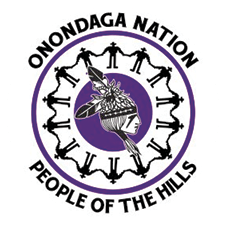Onondaga historian fights for memory of native vets
DICK CASE
Syracuse Post-Standard
There’s a lot more to this Veterans Day Weekend of ours than the coupon sales at the malls. Disbelievers need to spend time listening to Irving Powless Jr., a chief of the Onondaga Nation.
Irv is the son of a chief, secretary of the Onondaga Council of Chiefs and an avid historian of his people. He’s made a career out of correcting what he believes to be misunderstandings about the place of the Six Nations Iroquois Confederacy – aka Haudenosaunee – in American history.
He’s also a veteran. When the Korean War started, Irv was one of several Onondaga men who signed up for service in the American military.
His brother Hubert and another future chief, Oren Lyons, and Oren’s brother Lee also volunteered.
Irv served four years in the Navy, most of that time on The Randolph, one of those “floating city aircraft carriers.”
I saw Oren and Irv on Aug. 27 when Onondaga County dedicated a Wall of Honor to minority veterans of World War II, patriots who may have been left off the first Honor Roll put up when the War Memorial was built because they hadn’t enlisted, or been drafted, from Onondaga County.
The Wall of Honor is in the lobby of the Oncenter’s convention hall, across the street from the War Memorial. Another thing that’s missing in the Memorial Hall, by Irv’s measure, is a mannequin of a Native American soldier in uniform. Irv says he once pointed this out to County Executive Nick Pirro, who’s still “looking into it.”
That day in August, Oren, Irv and I looked at the 245 veterans’ names engraved in bronze. Oren ran his finger down the list, showing how many Native Americans were represented.
Irv, as he often does, pointed out “these are things that aren’t in your history books.”
He’s right.
Later, with Irv’s help and counsel from Albert Tarbell, a Syracusan who is of the Mohawk Nation, we figured out that the Iroquois stepped up honorably for World War II, even though they weren’t part of the draft. Of the 245 names on the wall that day, at least 87 were native people, including two women. Irv has since added one more name, Joseph Smith, an Navy vet from the Mohawk Nation.
Albert Tarbell was one of the veterans who got the idea of the wall into the heads of county officials four years ago, along with Cecil Cooper, an African-American who joined the Navy. Albert was a paratrooper.
When we talked later at his home at the Onondaga Nation, Irv said the wall’s record of the many Iroquois who enlisted for World War II speaks to the gift his people gave to their American brothers. “All of our young men went to war,” he observed. “There was nobody left except old people and young kids. Did any other community make that contribution?”
That included families of three and four brothers. Two of the young men were killed.
Irv wants us to know that military service by the Haudenosaunee is consistent through all American wars, from the Revolution to Iraq.
There’s a misconception, for example, that the Iroquois were allies of either Britain or the colonists in the American Revolution; they were, in fact, officially neutral, and Irv has seen the document to prove this in the National Archives. It’s an agreement between George Morgan, the U.S. Indian agent, and Six Nations chiefs, when they agreed with the colonists’ wish “the Haudenosaunee had to be neutral.”
Yes, Irv concedes, “when there’s a fight, individuals want to fight.” So, some Iroquois did take arms, but as mercenaries. “That doesn’t mean the Six Nations ‘lost the war.’ This isn’t in your history books.”
This historian says he’s often frustrated by the traditional history-book takes on the Iroquois, particularly the ones sanctioned by official state history keepers. So much so that Irv, and other Six Nations historians, set out 25 years ago to “tell history as it is” from their traditions and research.
The result is a draft of a work on its way to becoming a book called “Haudenosaunee: Past, Present and Future” that’s “this thick,” according to Irv, who shows me with his finger it’s a manuscript several inches deep.
“We sent it to the state commissioner of education,” Irv recalls. “They kept it 10 years and finally sent it back. The only comment was ‘thanks.’ We decided to publish it ourselves.”
Meanwhile, as the material is checked by chiefs around the confederacy, outlines are used in some of the nations’ schools, including Onondaga’s.
Irv says the draft discusses the Iroquois’ role in the Revolution, including how the Oneidas saved Washington’s army at Valley Forge by sharing their grain and the infamous raid on Iroquois villages after the war by the Sullivan expedition. Irv called the revengeful devastation “our 9/11.”
My friend is 76. Last February, a stroke took him down. He spends hours in therapy every day “teaching myself” back toward the man he used to be. It’s not easy, but he’s getting there.
His mind, by the way, is still as crisp as a raspberry branch in winter. He knows, for instance, how many beads there were in the wampum created for that 1775 agreement between the Americans and the Iroquois that held the Six Nations neutral:
“Two thousand five hundred.”
